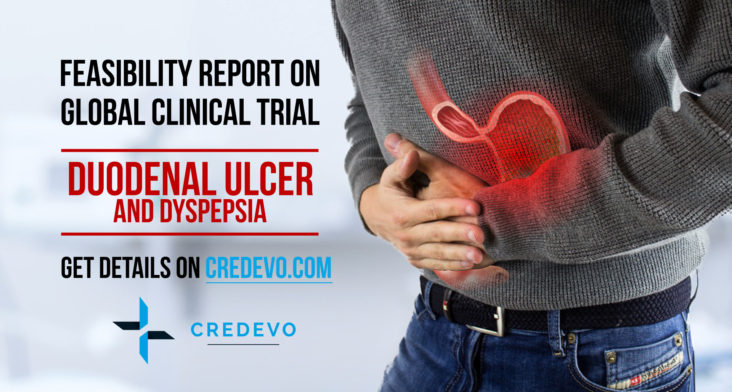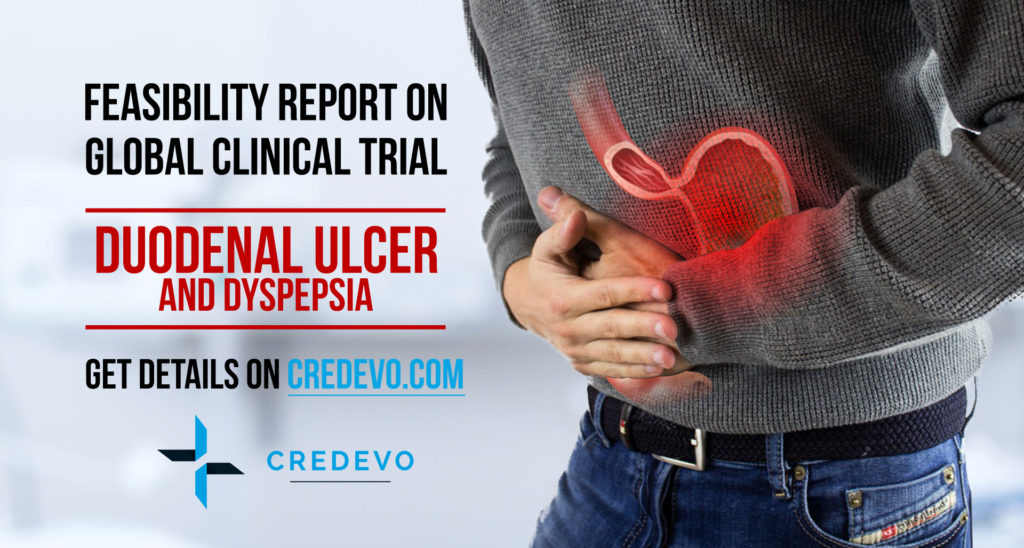3 Countries For Your Gastro Clinical Trials – Learning From A Duodenal Ulcer Trial Feasibility Report

The Gastrointestinal (GI) drugs market is a potentially huge market with many different indications, drug types, and treatment regimens.
Transparency Market Research and PRNewswire reports predict the global GI drugs market to grow with a CAGR between 4.5 % and 5.0 % from 2017 to 2023. While it was worth USD 46.5 Billion in 2016, it is estimated to reach US$61.6 bn by the end of 2024, expanding at a CAGR of 4.90%.
No wonder, it’s gaining a lot of interest from drug developers. Interest in the GI field is backed by strong market potential.

Regions for GI Clinical Trials
- A quick look at Clinicaltrials.gov provides interesting figures. A total of 27,022 clinical trials have been recorded in gastrointestinal disorders around the world, with most of them in North America (10,510), particularly the United States (9,615); Europe (7,916), and East Asia (5,501).
- Currently, ongoing studies on GI Disorders are 6,434, with North America (2,726), Europe (2,030), and East Asia (1,747), taking the biggest pie.
- Having considered this, it’s also clear that the potential of each region may vary with the type of GI indications being explored in the clinical trials.
Regions for Duodenal Ulcer and Dyspepsia Clinical Trials
While, GI trials include many different therapeutic indications, like ulcers, Crohn’s disease, IBD, etc., duodenal ulcer and dyspepsia are some of the significantly interesting fields for drug developers. Globally, a total of 108 studies are going on in duodenal ulcer mostly in East Asia (66), Japan (30), Europe (11), and North America (13).
In a recently performed assessment on Credevo, the feasibility of a clinical trial on Sucralfate was explored in duodenal ulcer and dyspepsia. The objective was to select the best regions for site identification and further site selection.
Out of the total 8 countries targeted, 3 countries stood out as the clear winners. These were Poland, Romania, and South Korea.
Poland, Romania and South Korea
Feasibility of clinical trial on duodenal ulcer and dyspepsia showed that these 3 countries could be very good site for GI clinical trials.
Let’s look at the details of this feasibility and understand more about these regions.
Target Regions for Feasibility
A group of countries from Europe, South Asia, South-East Asia, and East Asia was chosen based on the sponsor’s previous experience, viability, and expected recruitment potential.
These countries included
- India,
- Indonesia,
- Korea (south),
- Philippines,
- Thailand,
- Vietnam,
- Poland, and
- Romania
Clinical Trial Design for Feasibility
The study was designed as a Randomized, Double Masked, Parallel-Group, Placebo-Controlled, Multicentric Study to Evaluate the Efficacy and Safety of Sucralfate Suspension (1g/10 mL) in Subjects with Dyspepsia Symptoms and Endoscopically Confirmed Active Duodenal Ulcer.
This preliminary trial design was based on an earlier OGD (USFDA) recommendation for conducting a clinical trial for Sucralfate. Currently, this recommendation has been changed to exclude any clinical trial required.
Here are the two versions of OGD (USFDA) recommendations for Sucralfate submission.
- The current version of Sucralfate OGD recommendation
- An earlier version of Sucralfate OGD recommendation
The trial design included patients with duodenal ulcers and dyspepsia. Here are the main inclusion criteria considered.
- Ability to provide informed consent
- Male or females aged ≥ 18 and ≤ 65 years
- Subjects with dyspepsia symptoms along with one or two active duodenal ulcers of at least 3 mm in diameter and not exceeding 25 mm in diameter as determined by upper GI endoscopy.
- Subjects who are negative for H.pylori at baseline or subject continues to have the presence of an ulcer after appropriate treatment and eradication of H.pylori.
- Subjects who are willing to refrain from the use of any other ulcer treatment during the 8-week treatment period, other than the study treatment, provided antacid and acetaminophen.
- Subjects had no clinically significant findings on physical examination, ECG, clinical laboratory tests, and urine analysis at the discretion of the Principal Investigator.
Duodenal Ulcer and Dyspepsia
- Duodenal ulcer, an ulcer in the first part of the intestine (duodenum), is most likely caused by an alteration in the balance between the acid produced in the stomach and the natural mucus barrier protecting the lining of the duodenum.
- The most common symptoms of a duodenal ulcer are upper abdominal pain that may improve with eating. Other symptoms include belching, vomiting, weight loss, or poor appetite.
- Dyspepsia is a condition of impaired digestion, described by a group of symptoms, which may include pain, discomfort, bloating, feeling uncomfortably full after eating, nausea, loss of appetite, heartburn, burping up food or liquid (regurgitation), burping. In some cases, dyspepsia may be the first symptom of duodenal ulcer disease.
Feasibility Responses and Assessments Results
Results from this feasibility assessment threw interesting insights.
- Investigators in Poland, Romania, and South Korea were most responsive.
- More than 100% of the required responses were received.
- The average prospective recruitment rate was 3.44 patients per site per month.
- South Korean investigators reported the highest prospective recruitment rate of 5 patients per site per month, followed by investigators from Romania (4) and Poland (2.44).
- The highest individual prospective recruitment rate was 10 patients/site/month and the lowest was 1 patient/site/2 months.
These figures could be very helpful in planning studies in these regions.
Study Plan Based on Feasibility Results
Consider a scenario, where a referred study is going to be planned (although, it’s not recommended, as USFDA does not require this clinical trial for Sucralfate anymore) in these 3 countries. Besides the patient recruitment and treatment period, regulatory timelines will also play a major role in projecting the study duration.
Let’s assess the study timelines for this project with the following assumptions.
- Total patients to be recruited: 595
- Treatment period: 2 months
- The number of sites required: 15 with South Korea, Romania, and Poland having 5 sites each.
- Competitive recruitment among sites.
Regulatory Approvals
With a reasonable time-frame of 30 days for RA and IRB approval done in parallel, South Korea offers a very favorable time scenario (see more details on South Korea – Clinical Trials Regulatory Process).
This also gives South Korea, one extra month compared to Poland and Romania – both have 60 days as regulatory approval timelines. See regulatory process details on Poland and Romania.
Recruitment
Within approximately 10 months of recruitment, all 15 sites will be able to complete the target.
Total Project Timeline
Considering the above scenario, here is a most likely prospective project schedule
| Process | Date |
| Study Start (Assumption) | 1-Jan-2018 |
| Regulatory Submission Starts | 16-Jan-2018 |
| First Regulatory Approval | 15-Feb-2018 |
| First Patient Recruitment | 2-Mar-2018 |
| Last Patient Recruitment | 26-Jan-2019 |
| Last Patient Last Visit | 27-Mar-2019 |
Of course, with a change in basic assumptions, these timelines can be changed. But, the important aspect remains the quality investigators, who can provide a great recruitment rate.
Contact us, if you’d like to connect with these investigators from South Korea, Romania, and Poland
References
- https://patient.info/health/duodenal-ulcer
- https://www.medicinenet.com/dyspepsia/article.htm
- https://www.mayoclinic.org/diseases-conditions/peptic-ulcer/diagnosis-treatment/drc-20354229
- https://dailymed.nlm.nih.gov/dailymed/drugInfo.cfm?setid=0fb67b1c-b4c0-46f2-8a81-df1510e006aa
- https://en.wikipedia.org/wiki/Sucralfate
- https://www.prnewswire.com/news-releases/gastrointestinal-drugs-market-global-industry-analysis-trends-market-size–forecasts-to-2023-300528037.html
- https://www.transparencymarketresearch.com/gastrointestinal-drugs-market.html
- https://www.marketresearchfuture.com/reports/peptic-ulcer-drugs-market-2445
- http://www.wikinvest.com/stock/ViroPharma_(VPHM)/Fda_Guidance_Bioequivalence_Requirements_Locally-acting_Drugs_Fully_Supports
- https://www.fda.gov/downloads/Drugs/GuidanceComplianceRegulatoryInformation/Guidances/UCM573202.pdf